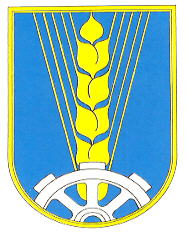Niesky district
The district of Niesky (initially the district of Weißwasser-Görlitz ) was a district in the state of Saxony that was created after the Second World War and was dissolved as early as 1952 as part of the administrative reform in the GDR. The district had an area of 1252 km², its seat was in Weißwasser until 1947 and since then in Niesky .
The former district area is completely contained in the north of the district of Görlitz (2106 km²) formed in 2008 .
history
During the Congress of Vienna in 1815 , the Kingdom of Saxony had to cede large parts of the country to Prussia , including more than half of Upper Lusatia . The Prussian part of Upper Lusatia was administratively subordinated to the Province of Silesia in 1816 (with the exception of the western tip) . The districts of Rothenburg , Görlitz and Lauban were founded in this area; In 1825 the western tip, which had been Brandenburg until then, was placed under Silesian administration as the district of Hoyerswerda . The city of Görlitz was spun off from the district of Görlitz as an urban district.
When the Oder-Neisse Line also cut this part of Upper Lusatia at the end of the Second World War , the district of Hoyerswerda, the greater part of the district of Rothenburg and the smaller part of the district of Görlitz were in the remaining German area; a small part of the Rothenburg district, the larger part of the Görlitz district and the Lauban district were under Polish administration. The city of Görlitz was also divided. By order of the Soviet military administration , the part of Upper Lusatia west of the Lausitz Neisse was reclassified to the State of Saxony on July 9, 1945 .
In October 1945, the district administration of the Rothenburg district was relocated from the now peripheral border town of Rothenburg / OL to the much larger town of Weißwasser , and the district was then renamed the Weißwasser district.
On January 16, 1947, the district of Weißwasser merged with the neighboring district of Görlitz to form the new district of Weißwasser-Görlitz based in Weißwasser, the city of Görlitz remained independent. The district seat was relocated in September 1947 from the largest, but very northerly, city of Weißwasser to the centrally located city of Niesky. District was Friedrich August Heiden ( SED ). It was not until January 12, 1948 that it was renamed the Niesky district.
During the district reform on July 25, 1952 , the district was split up and the districts of Weißwasser , Niesky and Görlitz-Land were created (from north to south) , with smaller border shifts (including Kromlau and the western part of Eigen ). .
coat of arms
The Niesky district used its own coat of arms from 1950 until the administrative reform in 1952. Grain ears and cogwheel were intended to symbolize the district's agriculture and industry, while the colors blue and yellow from the coat of arms of Upper Lusatia should symbolize that it belonged to Upper Lusatia.
In blue with a golden border behind a growing cog, a golden ear of corn adjoining the top.
literature
- The Niesky district. A journey through the past. Geiger publishing house. Horb am Neckar, 1993. ISBN 3-89264-843-3
Individual evidence
- ↑ a b From the Muskauer Heide to the Rotstein. Home book of the Lower Silesian Upper Lusatia District . Lusatia Verlag, Bautzen 2006, ISBN 978-3-929091-96-0 , p. 174 (173-175) .
- ^ Andreas Oettel: On the administrative structure of Saxony in the 19th and 20th centuries . In: State Statistical Office of the Free State of Saxony (Ed.): Statistics in Saxony . 175 years of official statistics in Saxony (Festschrift). No. 1 , 2006, p. 82 f . ( Online [PDF; 6.3 MB ; accessed on June 4, 2011]).
- ^ Eckhart Leisering: Coat of arms of the independent cities and districts in the Free State of Saxony . mdv, Mitteldeutscher Verlag, Halle / Saale 2000, ISBN 3-89812-069-4 , p. 84 .
